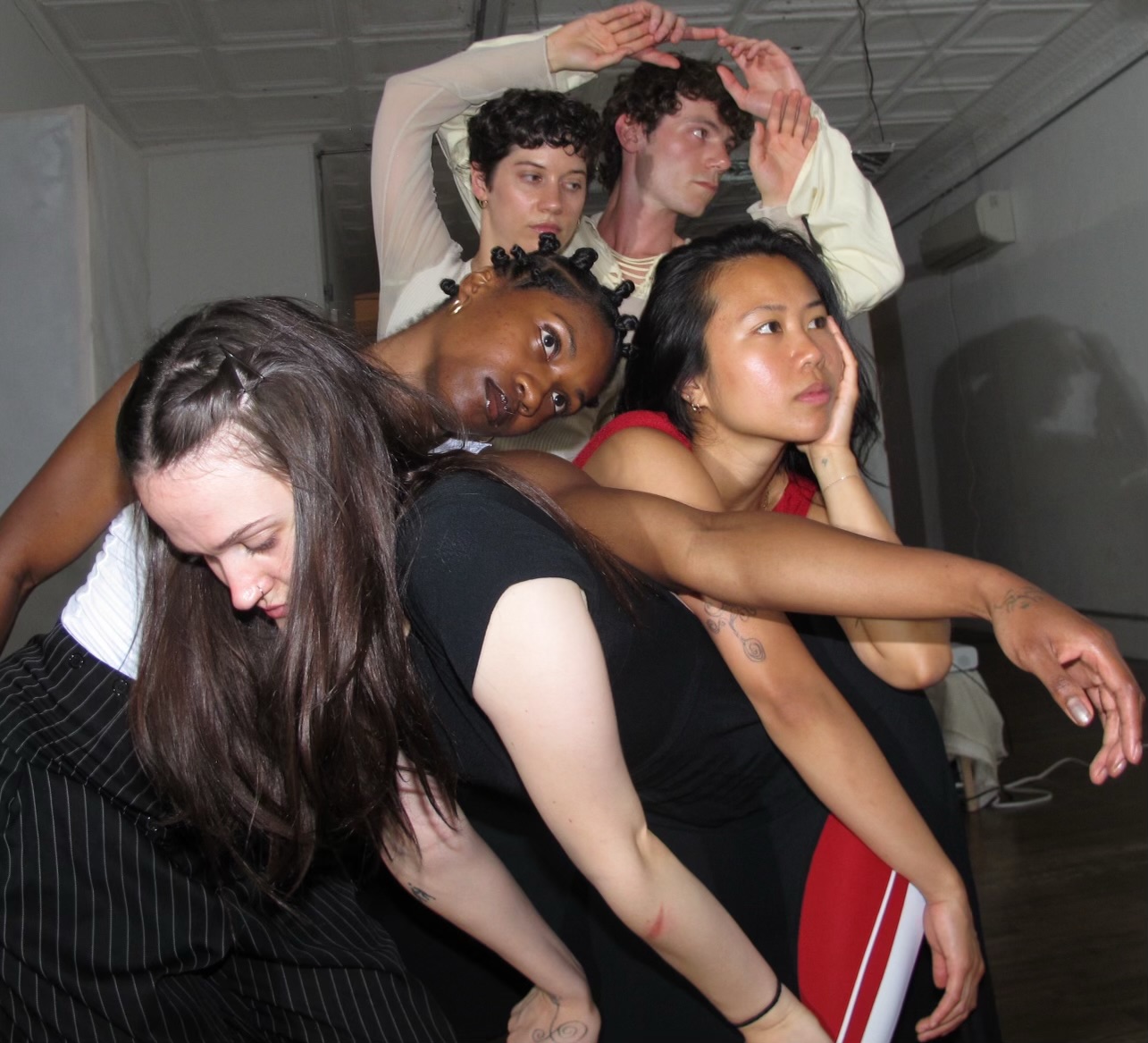Words by Liana Zhen-ai.
SHADOW BABY is the latest work by choreographer Maya Lee-Parritz. Presented at and by Pageant, an artist-run performance space in East Williamsburg, the work took place from June 5–6th, 2025.
As I ascended the stairs to Maya Lee-Parritz’s newest work, SHADOW BABY, a line of hopeful waitlist attendees snaked up to the second floor venue. The room was packed with audience members eager to see the choreographer’s six-member ensemble work. Four columns and a white panel decorate the stage, courtesy of set designer Richard McDonough, from which dancers would emerge, rest, and take shelter. A video of Lee-Parritz talking into a phone against deteriorating interior walls, or lying in the dirt, her bandaged leg resting on a picnic bench, was projected on the back screen as the audience ambled in. Following the success of Agua Viva – a work she created in collaboration with downtown dance legend (and Lee-Parritz’s professor at Barnard College), Jodi Melnick – expectations were high.
“I could use some beauty,” one audience member observed.
The opening duet between Rachel Gill and Tim Bendernagel delivered. Showing off Lee-Parritz’s inventive blend of gesture, sculptural post-modern shapes, and fluidity, the movement was a run-on sentence full of left turns. Gill’s performance was nearly chameleonic, transforming sharp turns and twists into soaring, rotating promenades. Gill and Bendernagel fell into unison, seemingly by happenstance, as easily as they fell into romantic postures reminiscent of Manet’s The Spanish Ballet. Repetitions emerged like favorite words you might return to, mid-argument. Which was much the point. The work, Lee-Paritz writes, emerges from “the polyrhythms of human community, and of human, spiritual and ecological life.” Unity, cycles, and discordance materialise in SHADOW BABY, Lee-Parritz creates a world which is whole and rigorous in its rhythms, but filled with playfulness, sly glances, and cheeky sensuality.
Somewhere in the stream-of-consciousness flow of Gill and Bendernagel’s duet, Cayleen del Rosario walks into the space, tucks her hair behind her ears, and launches into an impassioned solo full of shy stomps and gyrations. Her tremendous stage presence shifts the space, bringing equal parts sensuousness and practicality. The trio introduces themes that will emerge throughout the work: the sudden and unpredictable appearance of a new character, little pats down the torso sprinkled in among wide, swinging movements, and weight-sharing structures built from the dancers’ bodies that look like absurdist furniture pieces.
“We worked with theidea of how to locate the origin and ending point of any given form from different places,” Lee-Parritz writes. When two new dancers, Dorchel Haqq and Lucienne Parker, emerge from behind a final set of columns, there is both a sense of surprise and a feeling that all is right in the internal logic of Lee-Parritz’s world.
The rhythms that Lee-Parritz is so engaged with make themselves more transparent to the audience as the piece progresses. Overlaying the structure of the movement is a score by Lavinia Eloise Bruce that shifts glacially from ambient, meterless sound to a driving, bass drum beat. A work that reveled in a malleable relationship to time drops gently into a cadence of call and response. The dancers move between ensemble choreography, duets, trios and solos.
Against a backdrop of dancers lined up along the back wall, Haqq takes center stage for a solo that is gravitational in its physical mastery. A pattern of dancers walking toward the audience, near-confrontationally, emerges, although the piece never feels fully for the audience. The dancers smirk at one another, toss their hair and repeat gestures like taking a picture with an unreliable disposable camera. Some choices are almost ironic: in one section Parker does a series of Lateral Ts before returning to postmodern vocabulary. The moments of recognisable form fade as quickly as they appear, calling upon Lee-Parritz’s curiosity around rhythm and its discontents. As Henri Lefebvre writes in his seminal text, Rhythm analysis: “When it concerns the everyday, rites, ceremonies, fêtes, rules and laws, there is always something new and unforeseen that introduces itself into the repetitive: difference.”
At last, Lee-Parritz herself emerges, marching across the stage in a pair of radiantly silver track pants. The movement descends into a complex hand-clapping pattern, each of the dancers collaborating expertly to form an unpredictable rhythm. Just as a tree might appear to be one organism, but is in fact part of a wild, symbiotic network of decomposers, insects, mosses and microorganisms, the pattern is reliant upon the participation of each individual to stay whole.
Finally, Lee-Parritz is left clapping alone, as the rest of the ensemble form into one long shape across the stage, tracing each others’ skin all the while. Never decidedly serious nor silly, the work ends with a pervasive feeling of completeness and community.
